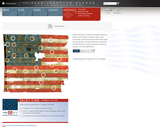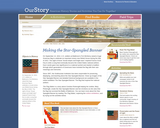
Students can learn abouth the Harvest Ceremony which is part of many Native American tribes.
- Provider:
- Smithsonian Institution
- Author:
- National Museum of the Native Americans
- Date Added:
- 06/24/2019

Students can learn abouth the Harvest Ceremony which is part of many Native American tribes.

Students will be able to cite the origins and outcome of the War of 1812 and be able to place the creation of the Star-Spangled Banner in a chronological framework.

Students will discuss, investigate, reflect, and make a photograph connected to the American flag. They will then write a detailed description that responds to one or more prompt questions and share both photographs and descriptions online.

Students will try an immigration interview from the early 1900s and consider the meanings behind those questions.

Students can access an interactive resource around the United States Flag from Fort McHenry which the Star-Spangled Banner poem was written about.

Students will investigate patterns in immigration through data
tables and data maps. They can also develop their own graphs to view the information in
other ways.

In this activity, students will watch and discuss a 22-minute video of a theater presentation created by the Smithsonian’s National Museum of American History. The activity could also include an in-classroom simulation, extension activities, and a sing- along performance of a freedom song.

Students learn about the Native American peoples who lived in the region which is now Oregon and Washington states.

Students will read a passage and write to answer questions based on the passage. This resource supports English language development for English language learners.

Students will read a passage, write answers to questions based on the passage, and write to explain and justify their position. This resource supports English language development for English language learners.

Students will learn about the importance of preserving Native culture and see how families share and pass down traditions. Students will gain an understanding of the ongoing Plains traditions of beadwork and quillwork"”decorative arts done with beads and porcupine quills"”and the "giveaway" (an honoring celebration). Students will explore the significance of designs and symbols found on dresses and better understand the Plains peoples"™ long-standing, close connection to their surroundings and natural resources.

In this lesson, students can learn about the traditions of the Sioux, who resided in the Midwestern part of the United States. This lesson focuses on their winter traditions, including the migration patterns which they followed.

Students can learn about the traditions of the Sioux, who resided in the Midwestern part of the United States. This lesson focuses on their winter traditions, including the migration patterns which they followed.

Students will learn the story of the flag that inspired the national anthem. An OurStory module entitled Making the Star-Spangled Banner, the resource includes links to hands-on activities and a list of recommended readings

In this video, students will learn about the flag from the War of 1812 which is on display at the Smithsonian Museum. They will learn about the history of the flag and the efforts which are being made to preserve it.

Students will be able to recite the first verse and paraphrase "The Star-Spangled Banner." Students will also be able to explain why Francis Scott Key wrote these words in 1814.

Students explore some of the other ways dolls can be important. Through interviews with Native doll makers, photographs of dolls similar to ones the doll makers have made, and supporting materials illustrating the environments the dolls come from. Students will see the larger connections between Native American dolls and the cultures they represent and will gain a greater understanding of the complexity and diversity of Native cultures.

In this lesson students will study Native Americans in order to become familiar with the contributions to and influences on American society particularly, but not exclusively, in the Western region of the United States. This lesson will focus on some of the cultural history, writings and symbols of the southwestern tribes. After researching, studying and comparing the differences among the various tribes in small groups, students will produce individual reports about a specific Native American perspective.

Students will learn about the connection Native people have to their natural world. Students will make observations about how the A:shiwi (also known as Zuni) people adapt to their environment and the cyclical aspect of their cultural and agricultural practices. Students will expand their knowledge through independent research on another Native community and their interactions with the natural world.

In this lesson, students will learn about the connection Native people have to their natural world. Students will make observations about how the A:shiwi (also known as Zuni) people adapt to their environment and the cyclical aspect of their cultural and agricultural practices. Students will expand their knowledge through independent research on another Native community and their interactions with the natural world.